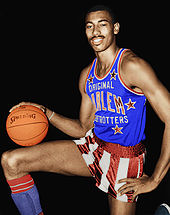Hack-a-Shaq
The strategy was originally adapted by Dallas Mavericks coach Don Nelson, who directed players to commit personal fouls throughout the game against selected opponents who shot free throws poorly.
Nelson initially used the strategy against Dennis Rodman, a Hall of Fame power forward for the Detroit Pistons, San Antonio Spurs and Chicago Bulls.
Teams sometimes defended him by bumping, striking or pushing him after he received the ball to deny him an easy layup or slam dunk.
[1][2][3] However, once Nelson's off-the-ball fouling strategy became prevalent, the term Hack-a-Shaq was applied to this new tactic and the original usage was largely forgotten.
The name is sometimes altered to reflect the player being fouled, for example Hack-a-Howard when used against Dwight Howard,[4] Hack-a-DJ for DeAndre Jordan,[5] or Hack-a-Ben for Ben Simmons.
[6] Committing repeated intentional personal fouls is a longstanding defensive strategy used by teams that are trailing near the end of the game.
However, fouling "off the ball" became a problem for the league when Wilt Chamberlain—a player of superstar caliber but a subpar free throw shooter—entered the NBA.
Wilt Chamberlain was such a dominant player that he was sure to be on the floor near the end of any close game; however, as a poor free throw shooter (51%), he became a natural target of a strategy of intentional fouling.
On such fouls within the last two minutes of the game or in overtime, the offensive team is awarded the usual number of free throws and then possession of the ball.
Intentional fouling every time the opponents get the ball was an innovation of Don Nelson in the late 1990s as coach of the Dallas Mavericks.
He theorized that if the opponents played an especially bad free throw shooter, intentionally fouling him might lower his team's points per possession when compared to a conventional defense against them.
[20] During the 2008–09 preseason, O'Neal expressed his disapproval of San Antonio Spurs coach Gregg Popovich and his team's use of the Hack-a-Shaq during the first round of the 2008 playoffs.
[18] On October 29, 2008, Popovich poked fun at O'Neal, having Michael Finley commit an intentional foul five seconds into the first game of the regular season.
O'Neal laughed when he looked over to the Spurs bench and saw Popovich smiling while giving two thumbs up, further asserting that it was a joke.
A potential reason for the lack of action was that the Lakers won both of the most notorious games where Hack-a-Shaq was used, suggesting that the strategy was too ineffective to require remediation.
He explained that Popovich used the tactic "to eliminate 3-point attempts" and with 25 seconds or less at the end of quarters to get the ball back for the Spurs to gain the last possession.
[29] NBA commissioner Adam Silver announced that the competition committee would look into changing the rule before the start of the 2016–2017 season due to extended length of games.
Ben Wallace shot only 42% free throws over his career, the worst percentage in the history of the NBA among players with 1000 attempts.
On January 12, 2012, the Golden State Warriors hacked Orlando Magic center Dwight Howard intentionally throughout the game.
[31] On May 29, 2012, the Oklahoma City Thunder used a so-called hack-a-Splitter strategy on Tiago Splitter during Game 2 of Western Conference Final of 2012 NBA Playoffs, who made 5 of 10 free throw attempts from these fouls.
[34] In turn, the Rockets targeted DeAndre Jordan, who had been victim of "Hack-a-Jordan" or "Hack-a-DJ" since 2014,[35][36] and in particular was fouled five times in two minutes during the previous playoff round against the San Antonio Spurs.
On November 29, 2017, the Washington Wizards used what a newspaper called a "hack-a-Ben Simmons strategy" when trailing the Philadelphia 76ers by 24 points in the third quarter.
The Wizards repeatedly fouled 76ers point guard Ben Simmons, giving him 29 free throws, 24 of them in the fourth quarter.
[44] On May 11, 2024, the Oklahoma City Thunder employed this strategy vs the Dallas Mavericks center Dereck Lively II in Game 3 of their Western Conference Semifinals series.
Some believe that frequently sending O'Neal to the foul line risked putting him "into a rhythm" and temporarily making him a better shooter.
[47] The rule change sought to eliminate cases where teams would intentionally foul off-the-ball in order to gain the final possession of a quarter.




